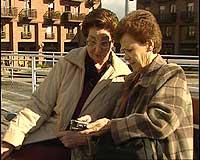New technologies to live peacefully in old age
Two projects developed at the Faculty of Informatics aim to improve the quality of life of people. One of them, called Aingeru, is aimed at older people living alone. There are currently home TV services for these people, but they only work inside the home. In the UPV/EHU this service has been improved, since the elderly carries with them an electronic agenda with which they can go out to the street. This system offers two options: on the one hand, if at some point it feels bad, the warning would reach a control room of an emergency center by stepping on the PDA itself.

On the other hand, this person can carry sensors in the body that allow to take data on the state of the organism: pulse, temperature, amount of glucose in blood, etc. This data is analyzed by the system and if it detects any problems, the system itself would automatically pass the warning. If the person is very bad, help would be sent immediately. The Matia Foundation has shown special interest in this project.
Another project developed at the UPV Faculty of Computer Science is MOLEC. The user has "ECG" sensors placed in the body. These sensors are associated with an electronic agenda. The goal is to control the functioning and rhythm of the heart and work faster before the sudden. If the heart rate begins to change, that is, if an arrhythmia occurs, the PDA will collect the data and movements of the arrhythmia and issue an alarm at the time it occurs in the health center.
This system is valid for all ages. Both systems are using wireless technologies. On the one hand, GSM or GPRS technology is used to send alarm alerts from electronic agendas to emergency services. According to the researchers, if there are WI FI networks in the places where users are located, they can also be used. On the other hand, UPV researcher Itziar Bagües explained that Bluetooth technology can be used to send sensor data to electronic agendas. "We want to use Bluetooth technology so that there are no cables. In this way, the person will not have to carry cables or computers with the sensors."
These systems, for the moment, are only prototypes, but the authors expect them to go to market. Through these systems, the health of users is more controlled and offers the user greater comfort and freedom.
Buletina
Bidali zure helbide elektronikoa eta jaso asteroko buletina zure sarrera-ontzian











